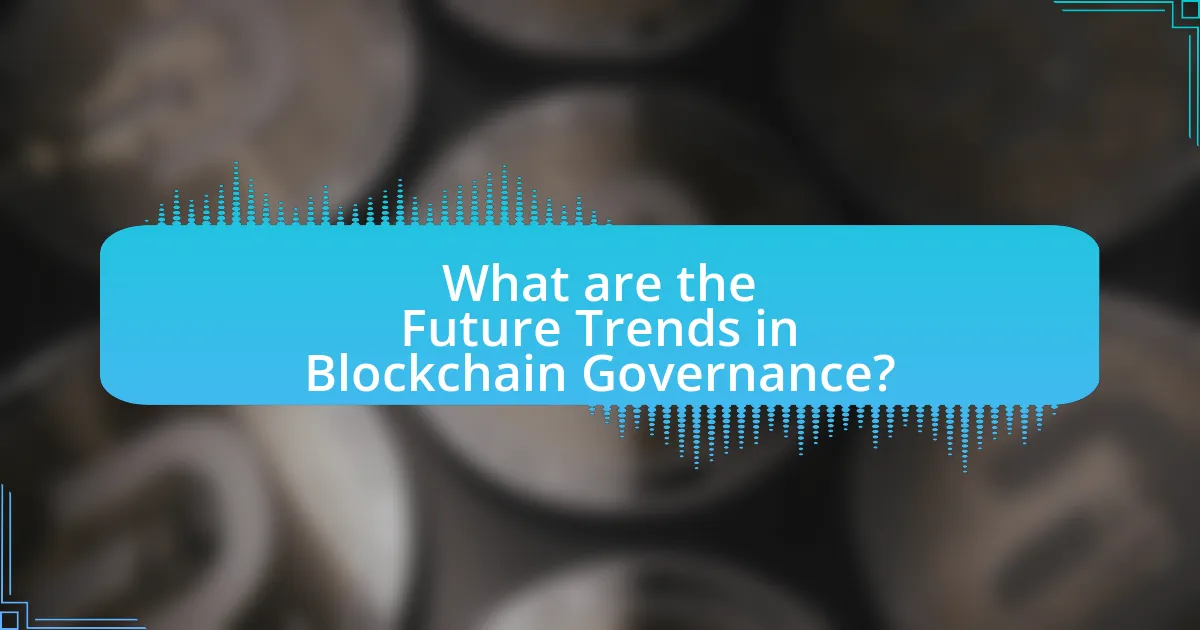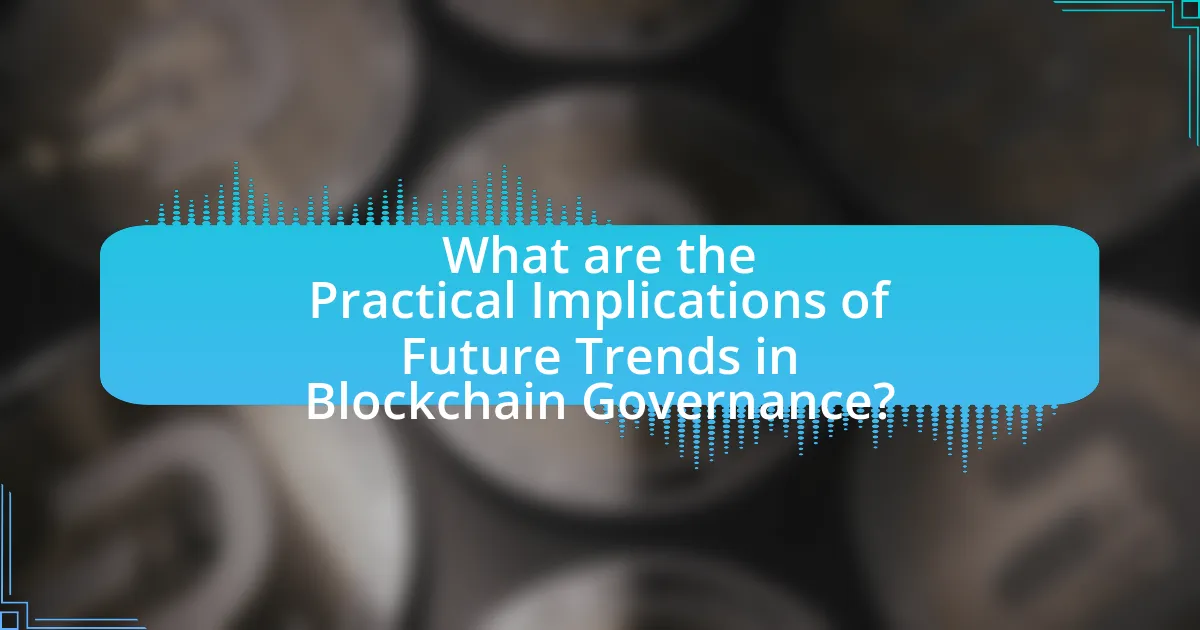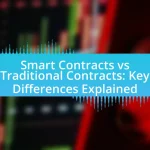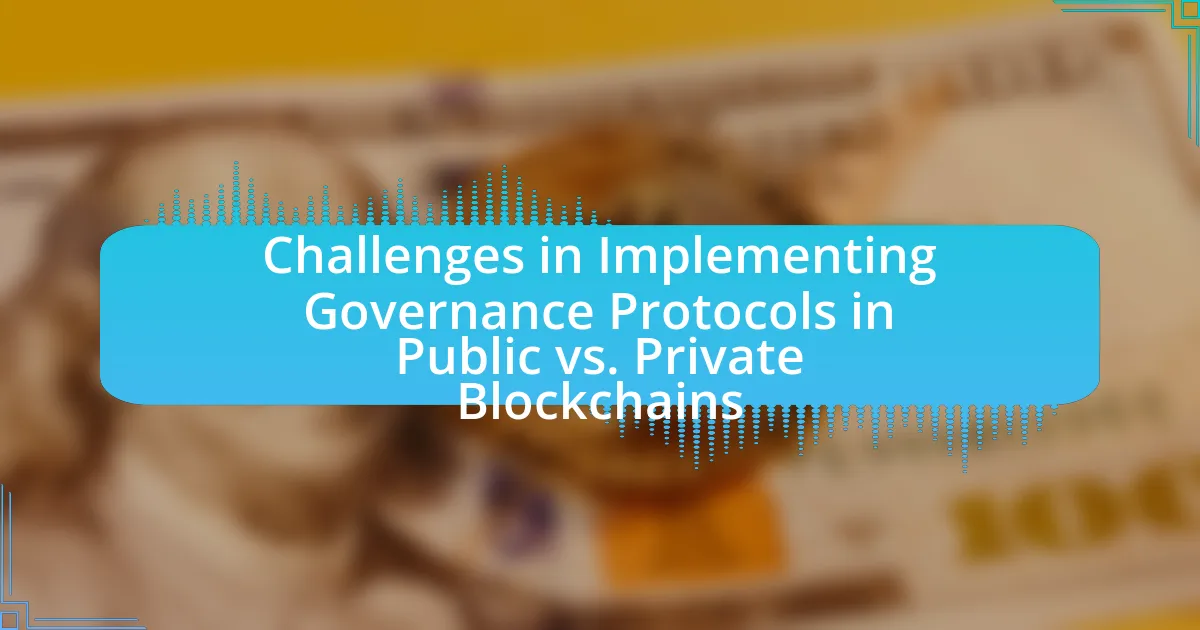The article focuses on the future trends in blockchain governance, highlighting key developments such as increased decentralization, enhanced regulatory frameworks, and the integration of artificial intelligence. It discusses the evolution of governance structures through decentralized autonomous organizations (DAOs), which promote democratic decision-making and transparency. Additionally, the article examines the impact of regulatory changes on governance models, the role of technological advancements like smart contracts, and the challenges faced by DAOs in achieving effective governance. Predictions about the future of blockchain governance suggest a shift towards more inclusive and accountable frameworks, emphasizing the importance of stakeholder engagement and compliance.

What are the Future Trends in Blockchain Governance?
Future trends in blockchain governance include increased decentralization, enhanced regulatory frameworks, and the integration of artificial intelligence for decision-making. Decentralization is expected to empower communities, allowing for more democratic participation in governance processes, as seen in projects like DAO (Decentralized Autonomous Organizations). Enhanced regulatory frameworks will likely emerge to address compliance and security concerns, as governments worldwide are beginning to establish clearer guidelines for blockchain technologies. Additionally, the integration of artificial intelligence can streamline governance by automating processes and improving transparency, as evidenced by initiatives that utilize AI to analyze blockchain data for governance decisions. These trends indicate a shift towards more inclusive, secure, and efficient governance models in the blockchain space.
How is blockchain governance evolving in the digital landscape?
Blockchain governance is evolving through increased decentralization, enhanced transparency, and the integration of regulatory frameworks. Decentralized autonomous organizations (DAOs) are gaining traction, allowing stakeholders to participate in decision-making processes, which promotes a more democratic governance structure. Additionally, blockchain projects are adopting transparent governance models that utilize smart contracts to automate and enforce rules, thereby reducing the potential for manipulation. The emergence of regulatory frameworks, such as the European Union’s MiCA (Markets in Crypto-Assets) regulation, is also shaping governance by providing guidelines that ensure compliance while fostering innovation. These developments indicate a shift towards more inclusive and accountable governance mechanisms in the blockchain ecosystem.
What technological advancements are influencing blockchain governance?
Technological advancements influencing blockchain governance include smart contracts, decentralized autonomous organizations (DAOs), and interoperability protocols. Smart contracts automate and enforce governance rules without intermediaries, enhancing efficiency and transparency. DAOs enable community-driven decision-making, allowing stakeholders to participate directly in governance processes. Interoperability protocols facilitate communication between different blockchain networks, promoting collaboration and cohesive governance frameworks. These advancements collectively enhance the adaptability, security, and inclusiveness of blockchain governance systems.
How do regulatory changes impact blockchain governance trends?
Regulatory changes significantly influence blockchain governance trends by establishing frameworks that dictate compliance, operational standards, and user protections. For instance, the implementation of the European Union’s Markets in Crypto-Assets (MiCA) regulation aims to create a unified regulatory environment, which encourages blockchain projects to adopt more structured governance models to ensure compliance. This shift towards regulatory clarity often leads to increased institutional investment and participation, as companies feel more secure in navigating the legal landscape. Furthermore, as regulations evolve, they can drive innovation in governance mechanisms, such as the development of decentralized autonomous organizations (DAOs) that align with regulatory requirements while maintaining decentralization principles.
What role do decentralized autonomous organizations (DAOs) play in blockchain governance?
Decentralized autonomous organizations (DAOs) play a crucial role in blockchain governance by enabling decentralized decision-making processes among stakeholders. DAOs utilize smart contracts to automate governance functions, allowing members to propose, vote on, and implement changes without centralized control. This structure enhances transparency and accountability, as all transactions and decisions are recorded on the blockchain, making them accessible for verification. For instance, the MakerDAO governs the DAI stablecoin through community voting, demonstrating how DAOs can effectively manage complex financial systems while distributing power among participants.
How are DAOs changing decision-making processes in blockchain networks?
DAOs, or Decentralized Autonomous Organizations, are fundamentally transforming decision-making processes in blockchain networks by enabling collective governance through smart contracts. This shift allows stakeholders to participate directly in decision-making without the need for intermediaries, thereby increasing transparency and accountability. For instance, in a DAO, proposals can be submitted and voted on by token holders, ensuring that decisions reflect the collective will of the community rather than a centralized authority. This model has been exemplified by platforms like MakerDAO, where governance tokens empower users to influence protocol changes, demonstrating a successful implementation of decentralized governance.
What challenges do DAOs face in governance structures?
DAOs face significant challenges in governance structures, primarily due to issues of decentralization, decision-making efficiency, and member engagement. Decentralization can lead to a lack of clear leadership, resulting in slow decision-making processes as consensus is often required from a diverse group of stakeholders. For instance, a study by the Blockchain Research Institute highlights that 70% of DAOs struggle with reaching timely decisions due to the need for extensive voting and deliberation among members. Additionally, member engagement can fluctuate, leading to apathy or low participation in governance activities, which undermines the effectiveness of the DAO. This is evidenced by the fact that many DAOs report participation rates below 30% in governance votes, indicating a disconnect between the organization and its members. These challenges hinder the ability of DAOs to operate efficiently and adapt to changing circumstances in the blockchain ecosystem.
What innovations are shaping the future of blockchain governance?
Decentralized Autonomous Organizations (DAOs) are a key innovation shaping the future of blockchain governance. DAOs enable community-driven decision-making through smart contracts, allowing stakeholders to vote on proposals and manage resources collectively. This model enhances transparency and accountability, as all transactions and decisions are recorded on the blockchain, making them immutable and publicly accessible. Additionally, innovations like on-chain governance mechanisms and token-based voting systems are emerging, allowing for more dynamic and responsive governance structures. These advancements facilitate greater participation and inclusivity in governance processes, aligning with the decentralized ethos of blockchain technology.
How are smart contracts enhancing governance mechanisms?
Smart contracts enhance governance mechanisms by automating decision-making processes and ensuring transparency in transactions. They facilitate trustless interactions among parties by executing predefined rules without the need for intermediaries, which reduces the potential for fraud and manipulation. For instance, in decentralized autonomous organizations (DAOs), smart contracts govern member voting and fund allocation, ensuring that all actions are recorded on the blockchain and are immutable. This transparency allows stakeholders to verify compliance with governance rules, thereby increasing accountability. Additionally, a study by the World Economic Forum in 2020 highlighted that smart contracts can streamline governance by enabling real-time auditing and reducing administrative overhead, further solidifying their role in enhancing governance mechanisms.
What new consensus models are emerging in blockchain governance?
New consensus models emerging in blockchain governance include Proof of Stake (PoS), Delegated Proof of Stake (DPoS), and Proof of Authority (PoA). PoS allows validators to create new blocks based on the number of coins they hold and are willing to “stake” as collateral, enhancing energy efficiency compared to Proof of Work (PoW). DPoS introduces a voting mechanism where stakeholders elect delegates to validate transactions, improving scalability and reducing centralization risks. PoA relies on a limited number of trusted nodes to validate transactions, which can lead to faster processing times and lower energy consumption. These models are gaining traction as they address the limitations of traditional consensus mechanisms, such as energy consumption and transaction speed, while promoting decentralization and security.

How do Predictions Influence Blockchain Governance Trends?
Predictions significantly influence blockchain governance trends by shaping stakeholder expectations and guiding decision-making processes. For instance, when experts forecast increased regulatory scrutiny, blockchain projects may proactively adopt compliance measures, thereby aligning their governance structures with anticipated legal frameworks. This proactive adaptation is evident in the rise of decentralized autonomous organizations (DAOs), which are designed to be more transparent and accountable in response to predictions about regulatory developments. Furthermore, research indicates that market sentiment, driven by predictions, can lead to shifts in governance models, as seen in the transition from proof-of-work to proof-of-stake systems, which are perceived as more sustainable and aligned with future environmental regulations. Thus, predictions serve as a catalyst for innovation and adaptation in blockchain governance.
What predictions are experts making about blockchain governance?
Experts predict that blockchain governance will increasingly adopt decentralized autonomous organizations (DAOs) to enhance decision-making efficiency and transparency. This shift is expected to empower stakeholders by allowing them to participate directly in governance processes, thereby reducing reliance on centralized authorities. Research indicates that DAOs can improve accountability and foster community engagement, as evidenced by the rise of successful DAOs like MakerDAO and Aragon, which have demonstrated effective governance models. Additionally, experts foresee the integration of artificial intelligence in governance frameworks to analyze data and optimize decision-making, further streamlining processes and enhancing adaptability in rapidly changing environments.
How might these predictions affect future governance frameworks?
Predictions regarding blockchain governance will likely lead to more decentralized and transparent governance frameworks. As blockchain technology matures, governance models are expected to evolve towards increased participation from stakeholders, reducing reliance on centralized authorities. For instance, the rise of decentralized autonomous organizations (DAOs) exemplifies this shift, where decision-making is distributed among token holders, enhancing accountability and inclusivity. Additionally, the integration of smart contracts can automate governance processes, ensuring compliance and reducing administrative overhead. These trends indicate a movement towards governance frameworks that prioritize stakeholder engagement and operational efficiency, aligning with the principles of decentralization inherent in blockchain technology.
What are the potential risks associated with these predictions?
The potential risks associated with predictions in blockchain governance include regulatory uncertainty, technological vulnerabilities, and market volatility. Regulatory uncertainty arises as governments may impose restrictions or change laws affecting blockchain operations, which can disrupt projects and investments. Technological vulnerabilities refer to the possibility of security breaches or bugs in smart contracts, which can lead to significant financial losses, as evidenced by incidents like the DAO hack in 2016, where $60 million was stolen due to a vulnerability. Market volatility can result from speculative investments and sudden shifts in public perception, leading to drastic price fluctuations that can jeopardize the stability of blockchain projects.
How can organizations prepare for future trends in blockchain governance?
Organizations can prepare for future trends in blockchain governance by adopting adaptive governance frameworks that incorporate stakeholder engagement and regulatory compliance. These frameworks should be designed to evolve with technological advancements and changing regulatory landscapes, ensuring that organizations remain agile and responsive. For instance, the World Economic Forum’s report on blockchain governance emphasizes the importance of multi-stakeholder collaboration to address governance challenges effectively. By fostering partnerships with regulators, industry leaders, and technology experts, organizations can better anticipate and respond to emerging trends in blockchain governance.
What strategies should organizations adopt to stay ahead?
Organizations should adopt a proactive approach to innovation and collaboration to stay ahead in the rapidly evolving landscape of blockchain governance. Emphasizing continuous research and development allows organizations to identify emerging trends and technologies, ensuring they remain competitive. For instance, a study by Deloitte in 2021 highlighted that organizations investing in blockchain technology saw a 30% increase in operational efficiency. Additionally, fostering partnerships with tech startups and academic institutions can provide access to cutting-edge solutions and insights, further enhancing an organization’s adaptability and responsiveness to market changes.
How can organizations leverage innovations in blockchain governance?
Organizations can leverage innovations in blockchain governance by implementing decentralized decision-making processes that enhance transparency and accountability. By utilizing smart contracts, organizations can automate governance protocols, ensuring that rules are enforced without the need for intermediaries. For instance, the use of decentralized autonomous organizations (DAOs) allows stakeholders to participate in governance decisions directly, which can lead to more democratic and efficient outcomes. Research indicates that organizations adopting blockchain governance frameworks experience increased trust among participants, as evidenced by a study published in the Journal of Business Research, which found that transparency in blockchain systems significantly improves stakeholder engagement and satisfaction.

What are the Practical Implications of Future Trends in Blockchain Governance?
Future trends in blockchain governance will lead to increased decentralization, enhanced transparency, and improved regulatory compliance. As blockchain technology evolves, governance models are shifting towards decentralized autonomous organizations (DAOs), which empower stakeholders to participate in decision-making processes. This shift enhances transparency by allowing all participants to access and verify governance actions on the blockchain. Furthermore, the integration of smart contracts in governance frameworks ensures that compliance with regulations is automated and verifiable, reducing the risk of fraud and increasing trust among users. For instance, a report by the World Economic Forum highlights that by 2025, 10% of global GDP could be stored on blockchain, emphasizing the importance of robust governance structures to manage this growth effectively.
How can businesses implement effective blockchain governance practices?
Businesses can implement effective blockchain governance practices by establishing clear frameworks that define roles, responsibilities, and decision-making processes. This involves creating governance structures that include stakeholders from various sectors, ensuring transparency and accountability in operations. For instance, organizations can adopt decentralized governance models, such as DAOs (Decentralized Autonomous Organizations), which facilitate collective decision-making and enhance stakeholder engagement. Research indicates that companies utilizing structured governance frameworks experience improved compliance and risk management, as evidenced by a study published in the Journal of Business Research, which highlights that firms with robust governance mechanisms are 30% more likely to succeed in blockchain initiatives.
What best practices should organizations follow for governance implementation?
Organizations should follow best practices such as establishing clear governance frameworks, ensuring stakeholder engagement, and implementing robust compliance mechanisms for effective governance implementation. Clear governance frameworks provide structured guidelines that define roles, responsibilities, and decision-making processes, which are essential for accountability. Engaging stakeholders fosters transparency and inclusivity, allowing diverse perspectives to shape governance policies. Additionally, robust compliance mechanisms ensure adherence to regulations and standards, mitigating risks associated with non-compliance. These practices are supported by research indicating that organizations with well-defined governance structures experience improved performance and reduced operational risks.
How can organizations measure the effectiveness of their governance strategies?
Organizations can measure the effectiveness of their governance strategies by utilizing key performance indicators (KPIs) that assess compliance, risk management, and stakeholder engagement. These KPIs can include metrics such as the percentage of regulatory compliance achieved, the frequency and severity of risk incidents, and stakeholder satisfaction scores. For instance, a study by the Harvard Business Review found that organizations with robust governance frameworks experience 30% fewer compliance violations, indicating a direct correlation between governance effectiveness and compliance outcomes. Additionally, regular audits and feedback mechanisms can provide insights into governance performance, allowing organizations to make data-driven adjustments to their strategies.
What common challenges do organizations face in blockchain governance?
Organizations face several common challenges in blockchain governance, including regulatory uncertainty, scalability issues, and stakeholder alignment. Regulatory uncertainty arises from the evolving legal landscape surrounding blockchain technology, which can hinder compliance and operational strategies. Scalability issues refer to the limitations in transaction processing speed and capacity, impacting the efficiency of blockchain networks. Stakeholder alignment involves the difficulty in achieving consensus among diverse participants with varying interests and objectives, which can complicate decision-making processes. These challenges are critical as they directly affect the implementation and effectiveness of blockchain governance frameworks.
How can organizations overcome these challenges?
Organizations can overcome challenges in blockchain governance by implementing robust frameworks that enhance transparency and collaboration. Establishing clear governance structures, such as decentralized autonomous organizations (DAOs), allows stakeholders to participate in decision-making processes, thereby increasing trust and accountability. Additionally, investing in education and training for employees on blockchain technology can mitigate knowledge gaps and foster innovation. Research indicates that organizations adopting these strategies experience improved stakeholder engagement and operational efficiency, as seen in case studies from companies like IBM and ConsenSys, which have successfully navigated governance challenges through structured approaches and community involvement.
What resources are available for organizations seeking to improve governance?
Organizations seeking to improve governance can access a variety of resources, including frameworks, guidelines, and tools specifically designed for governance enhancement. Notable resources include the ISO 37000 standard for governance of organizations, which provides principles and guidelines for effective governance practices. Additionally, the OECD Principles of Corporate Governance offer a comprehensive framework that promotes transparency, accountability, and fairness in governance structures.
Furthermore, organizations can utilize governance software solutions, such as Diligent or BoardEffect, which facilitate board management and enhance communication among stakeholders. Research reports from institutions like the World Economic Forum also provide insights into governance trends and best practices, aiding organizations in aligning their governance strategies with emerging standards and innovations in blockchain governance.

















